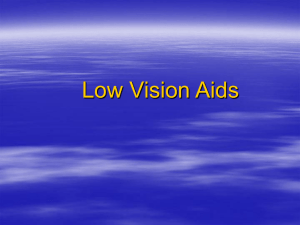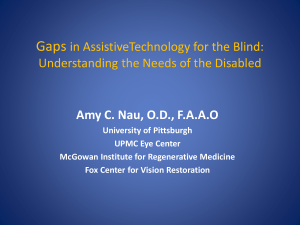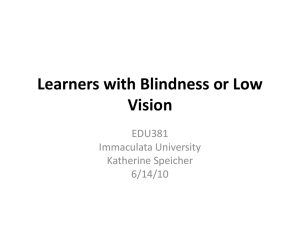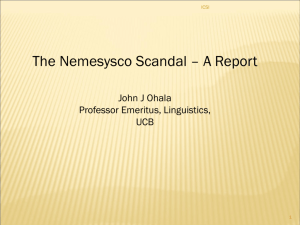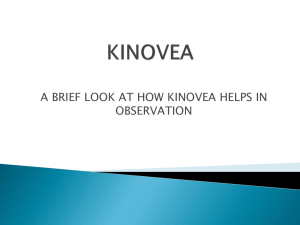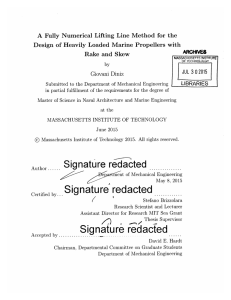Albert Israfil_Causes of blindness and functional vision in children
advertisement
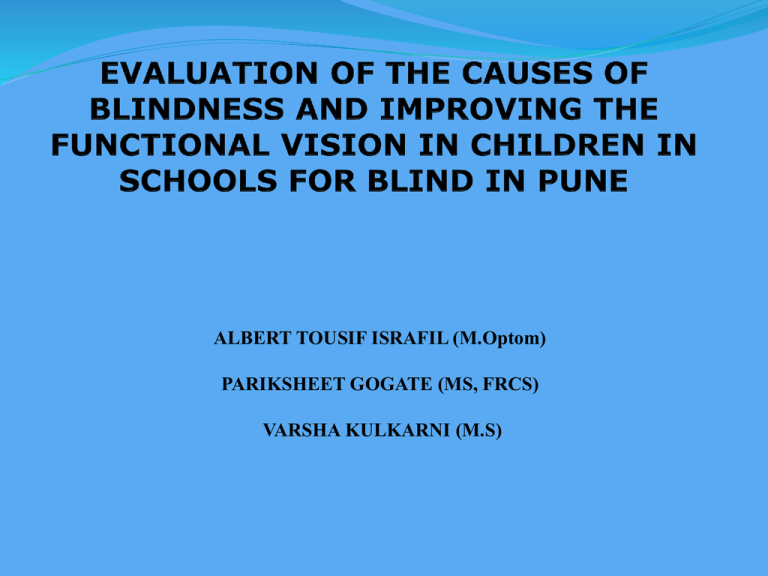
ALBERT TOUSIF ISRAFIL (M.Optom) PARIKSHEET GOGATE (MS, FRCS) VARSHA KULKARNI (M.S) AIM AND OBJECTIVE Aim: To evaluate the causes of blindness in children attending Schools for Blind in Pune and to record their improvement in functional vision with optical LVAs. Objectives: 1. Causes of blindness among children in schools for blind in Pune. 2. Children in school for blind, who have Low Vision. 3. Improvement in visual acuity with optical LVAs. Prospective study 1. Poona School & Home For Blind Boys, Koregaon Park. 2. Poona School & Home For Blind Girls, Kothrud. 3. Patashibai Lunkar Blind School, Panjarpur, Bhosari. 4. NFBM Jagriti School For Blind Girls, Alandi Devachi, Khed. Inclusion Criteria: All the candidates attending Schools for Blind between the age of 5-20 years of both the genders. Exclusion Criteria: 1. Candidates absent from school. 2. Patients not willing to participate in study. Materials and Procedure: Materials: 1.APPASWAMI AIA11 SLIT LAMP 2. HEINE BETA 200 Ophthalmoscope (US Pat 4.963.014) 3. HEINE BETA 200 Retinoscope (US Pat.5.859.687). 4.UNIQUE Distance Visual Acuity Test Chart (logMAR chart) calibrated for 4 meters & reduced snellen chart for near. 5.Telescopes of 2.25x,3.5x from Unique Educational Equipments 6.Magnifiers of (i) 5x illuminated stand magnifier (ii) 7.5x illuminated stand magnifier (iii) 2.5x stand magnifier (iv) 7.5x stand magnifier (v) 1.75x bar magnifier (vi) 1.75x fresnel magnifier (vii) 10D, 15D hand held magnifiers (viii) spot magnifiers of 24D, 32D, and 40x from Unique Educational Equipments were used. Procedure: ‘WHO/PBL Eye Examination Record For Children With Blindness And Low Vision’ Step 1: History taking of patient Step 2: Visual Acuity Assessment Step 3: Functional Vision Assessment: Step 4: General Assessment Step 5: Previous Eye Surgery Step 6: Torch light, Slit lamp Examination and Ophthalmoscopy Step 7: Refraction Step 8: Low Vision Aid Assessment Step 9: Action Needed Step10: Full Diagnosis Statistical Analysis: Microsoft Excel and SPSS software. RESULTS I. Gender Distribution and onset of visual loss: Gender Distribution Onset of Visual Loss since birth first year of life after 1yr of birth 415 90% Female 46.53% Male 53.47% 19 4% 17 4% 9 2% unknown II. Family History and Consanguinity: Family History Consanguinity 350 250 64.34% 300 46.95% 42.39% 200 200 family hisory 150 20.66% unknown 50 15% 0 50 0 family hisory no family history unknown history of consanguinity 100 no family history 150 100 Students Population 250 10.65% no history of consanguinity unknown III. Visual Assessment: No. of Patients Unaided Visual Acuity 180 160 140 120 100 80 60 40 20 0 164 35.6% 99 21.5% 38 8.2% 20 4.3% 48 10% pl-ve pl+ve HM FCCF 1.8 34 7.3% 1.5 24 5.2% 19 4.1% 1.3 1 Visual Acuity 6 1.3% 4 0.9% 2 0.4% 1 0.2% 1 0.2% 0.9 0.8 0.7 0.6 0.3 VI. Functional Vision: Functional Vison No. of Patients Can walk around 192 (41.73%) Recognise face 116 (25.21%) See prints 82 (17.82%) V. General Assessment: General Assessment 98% no additional disability hearing loss mental retardation physical handicap 1% 0.21% 1% VI. Site of Abnormality: Anatomical Site of Abnormality Cornea 25% Lens 18% Uvea 5% Retina 10% Whole Globe 36% optic nerve 6% Whole globe: Condition No. of Patient Microphthalmos 88(19.13%) Anophthalmos 54(11.73%) Phthisis 16(3.47%) Buphthalmos 3(0.43%) Removed 2(0.43%) Disorganised 2(0.43%) Endophthalmos 2(0.43%) Condition No. of Patients Anterior Staphyloma 48 (10.43%) Corneal Opacity 23 (5%) Corneal dystrophy 17 (3.69%) Keratoconus 7 (1.52%) Scar 6 (1.3%) Micro cornea 3 (0.65%) Cornea: Retina: Conditions No. of Patients Retinal dystrophy 17 (3.69%) Albinism 10 (2.17%) Retinitis pigmentosa 7 (1.52%) Retinopathy of Prematurity 6 (1.30%) CRVO 3 (0.65%) Lens: Number of patient with cataract and PCO were 78 students VII. LVA Assessment: LVA for distance: LVA for Distance 450 401; 87.17% 400 350 300 250 2.25x 3.5x 200 not prescribed 150 100 50 48; 10.43% 11; 2.40% 0 2.25x 3.5x not prescribed LVA for near: LVA for Near 40 35 34 47.2% 30 22 30.5% 25 5x illuminated sm 7.5x illuminated sm 2.5x sm 20 7.5x sm bar magnifier 15 fresnel prism 6 8.3% 10 5 5 6.9% 2 2.7% 2 2.7% 1 1.38% 0 5x illuminated 7.5x sm illuminated sm 2.5x sm 7.5x sm bar magnifier fresnel prism hand held mag. hand held mag. VII. Improvement with LVA: VA attained with magnifiers 25 22 4.78% No.of students 20 20 4.34% 21 4.56% 15 10 5 1.08% 5 1 0.21% 1 0.21% 1 0.21% 1 0.21% N16 N18 N24 0 N6 N8 N10 N12 N14 Near vision notations Visual acuity for distance which was below 1in logMAR (unaided) in RE and LE has improved to 1.0(RE) and 0.9(LE) in logMAR with LVA for distance. Total LVA Prescribed: Percentage of children benifited with LVA Not prescribed 83.26% LVA prescribed 16.74% Areas Of Improvement: 1.Data collected were from starting 5 years of age. 2.Children only of 4 schools were obtained. 3. Unavailability of telescopes from the manufacturers, made the examiner bound to use only two options (2.25x and 3.5x) for the distance LVA assessment. 4. Retinoscopy and ophthalmoscopy were done in undilated pupil. 5. Only optical LVA were used. CONCLUSIONS The major causes of blindness in children microphthalmos and anophthalmos. Avoidable blindness like cataract accounted in 78 students. Lack of follow up and ampblyopia treatment. Corneal blindness also accounted for 29% students. Out of the 460 students, 16.74% improved with LVA. Students with Low vision were not given a chance prior to this study to improve their functional vision. Regular print rather than Braille. Visual Acuity achieved upto logMAR 1.0 and Near acuity upto N6. THANK YOU





